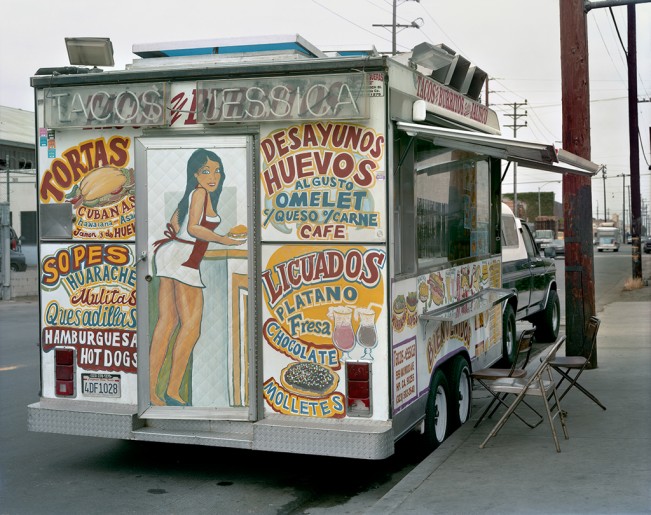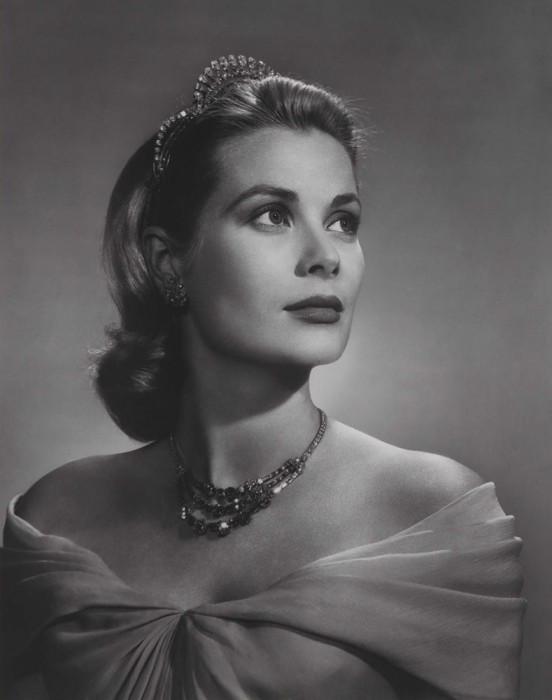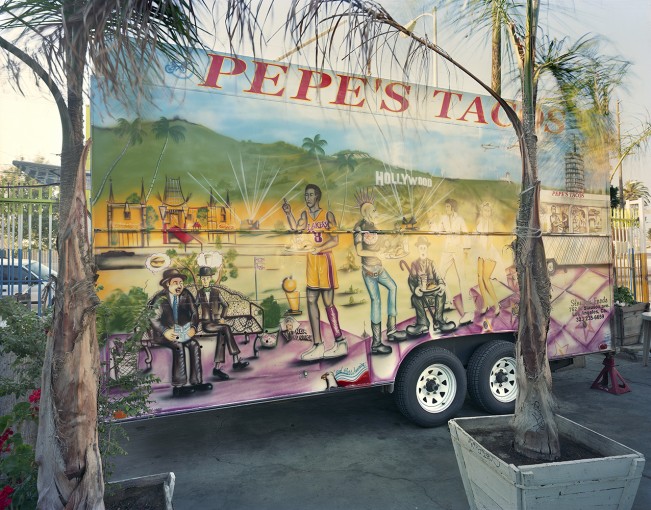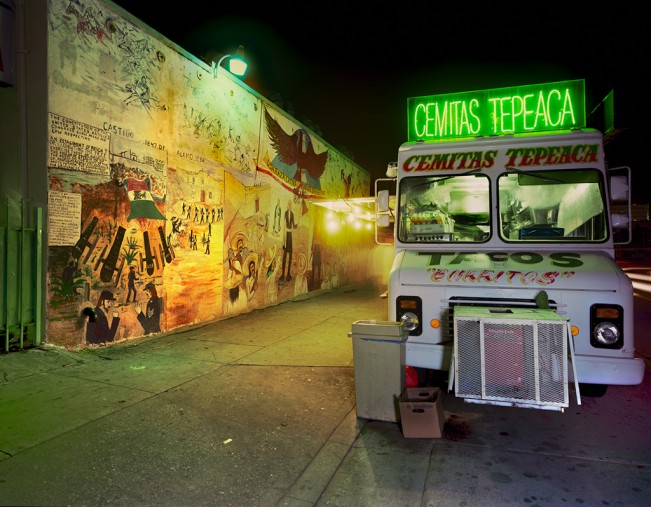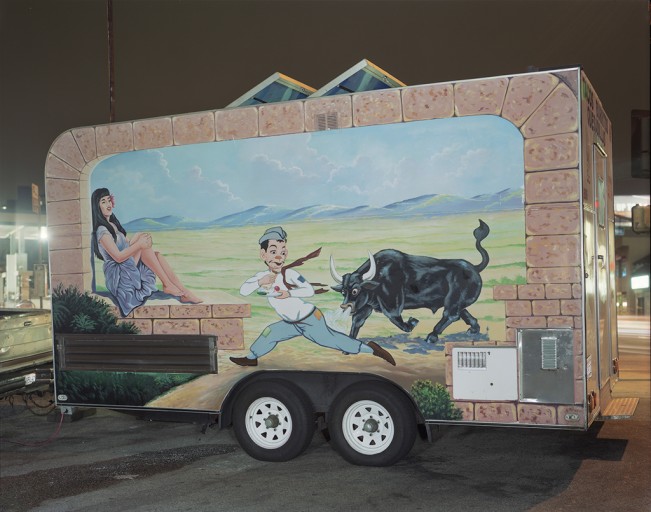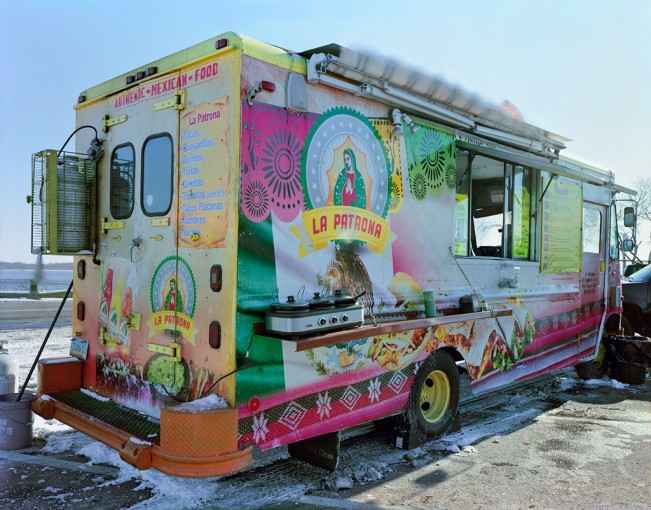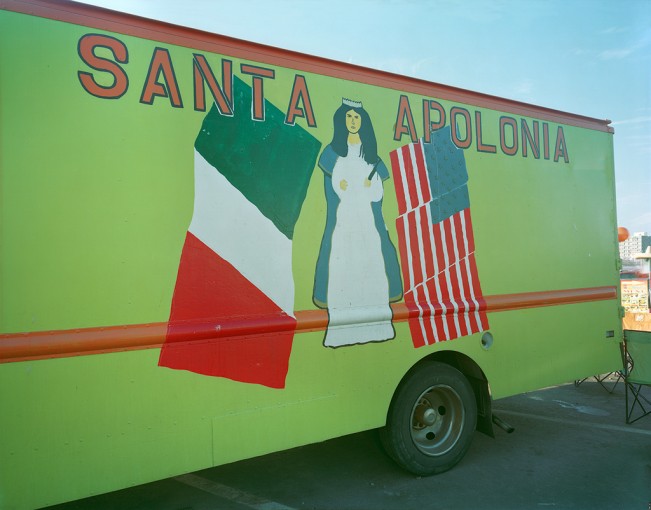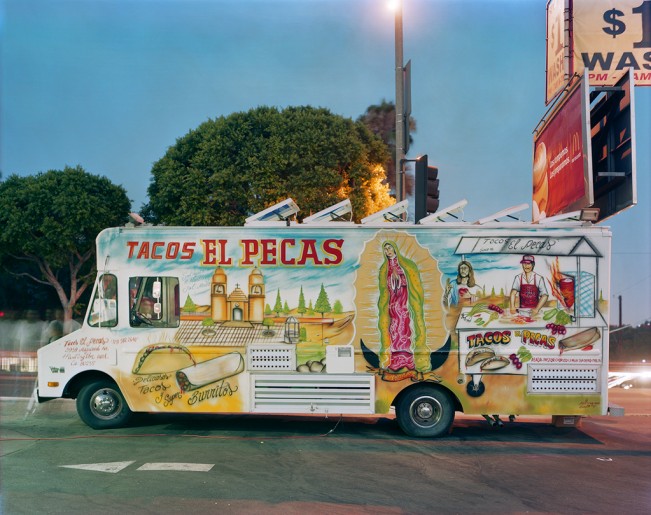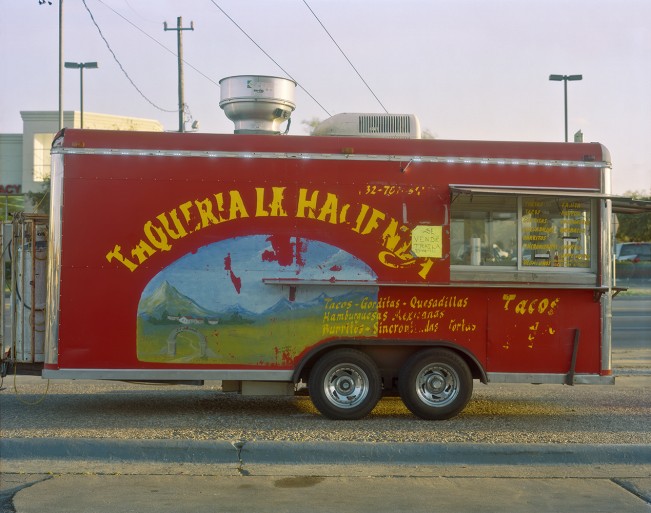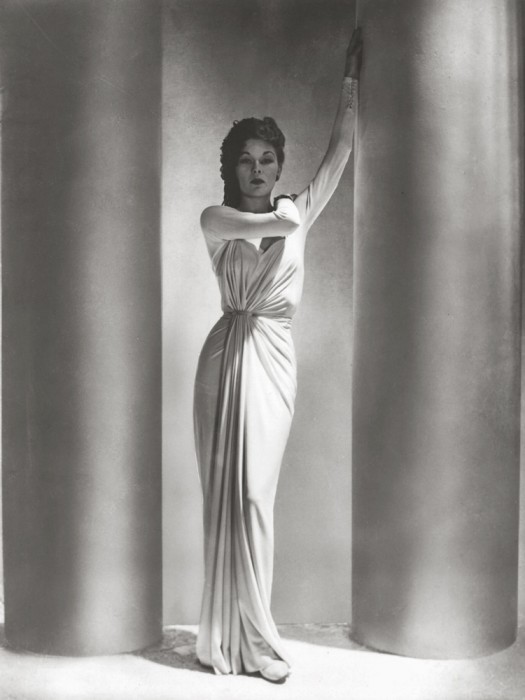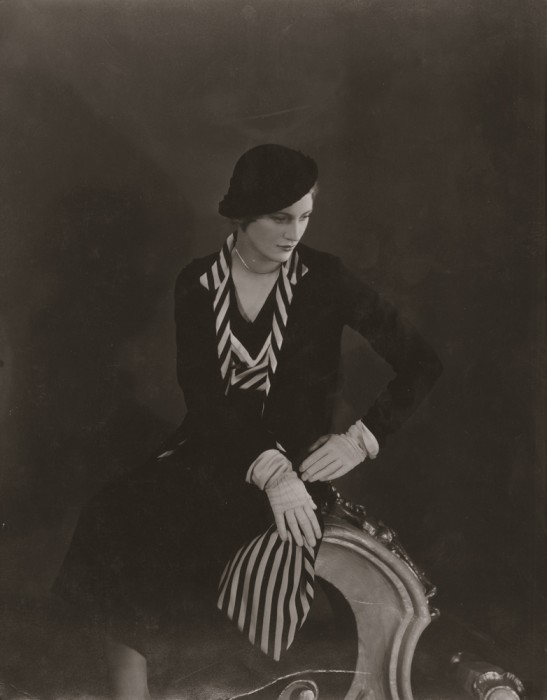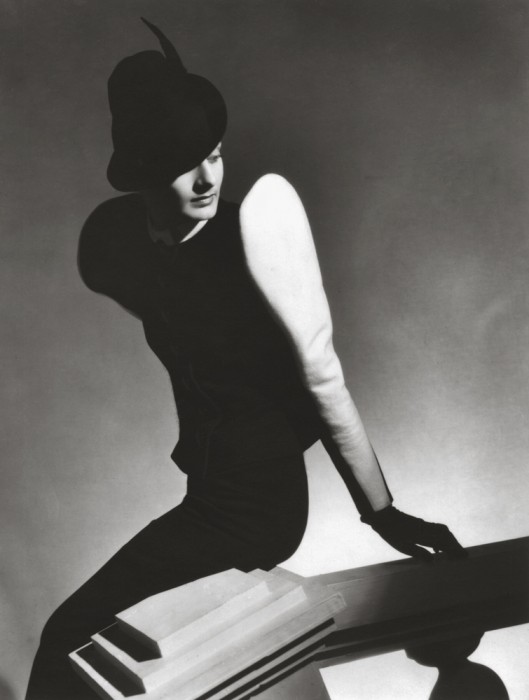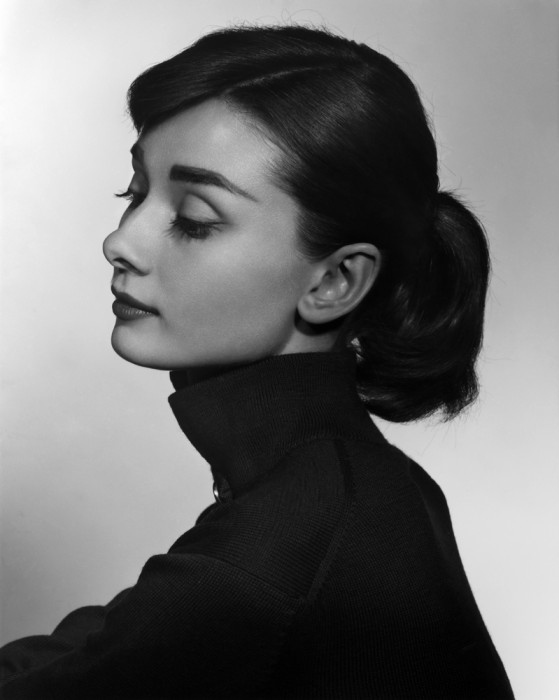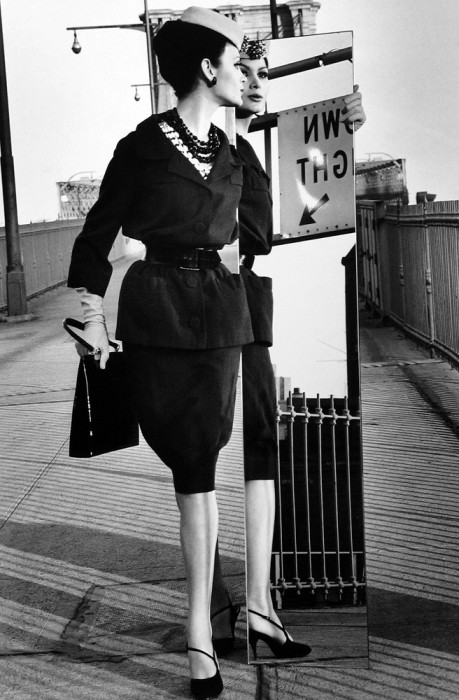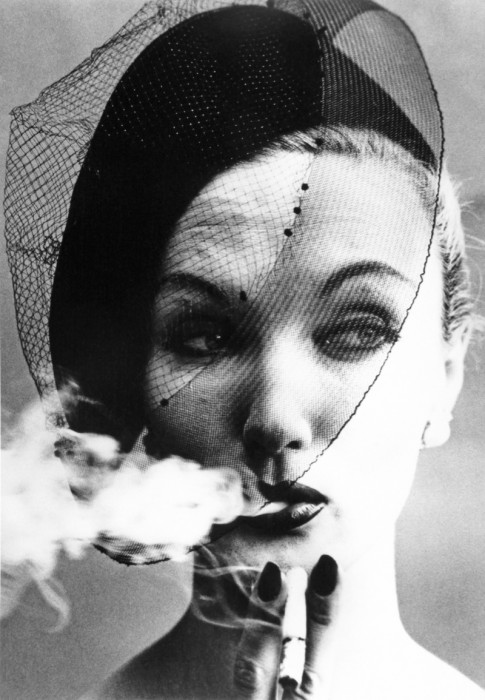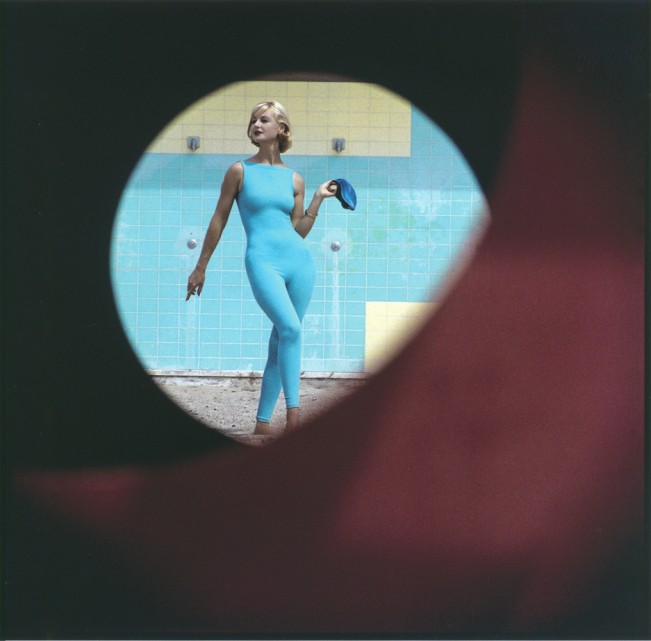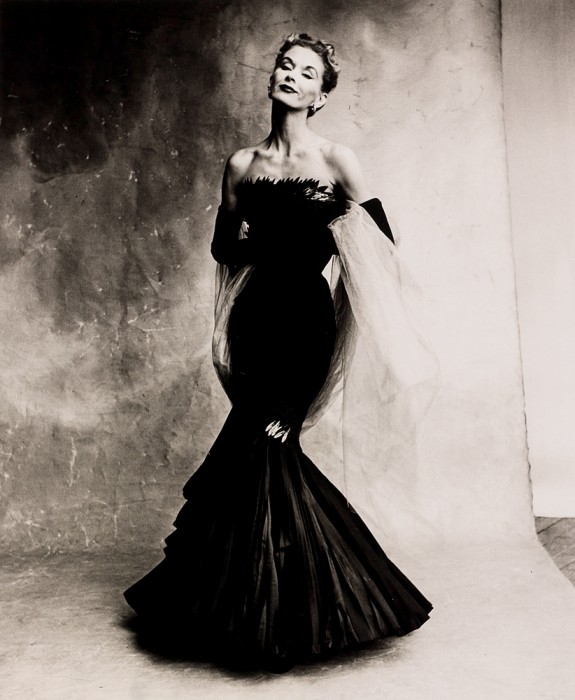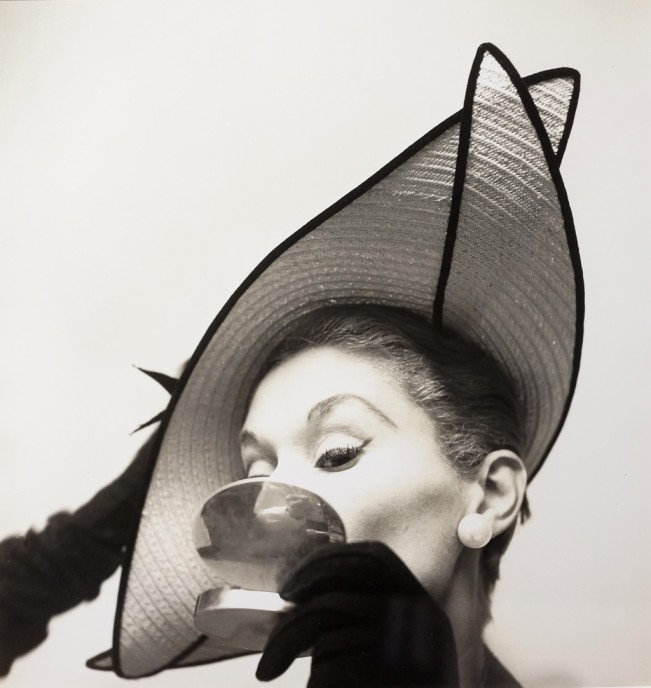Tacos and Tiaras at the Robert Klein Gallery
The Robert Klein Gallery has a current offering of dual exhibitions that are delicious in more ways than one. The unlikely pairing of Jim Dow’s Taco Trucks, Taquerías, and Carritos and WOMEN IN CLOTHES: 20th Century Fashion Photographers: Horst P. Horst, Yousuf Karsh, William Klein, Gordon Parks, Irving Penn, Man Ray is a humorous aligning of a culture of eating and a culture of not eating. For me personally, what’s better than imaging a delicious taco while fantasizing about fashion in the ’50s? Food plus Fashion=Heaven. Both exhibitions run through September 12th.
The exhibition Taco Trucks, Tacquerias, and Carritos reflects a ten-year capture of a wide variety of Latin American food stands, cultural standbys whose goods are, for many, a daily staple. Ranging from utilitarian, unadorned carts to trucks laden with neon signs, the establishments in these photographs are run by native Spanish speakers. These businesses are not run by celebrity chefs, they do not follow gastronomic trends, and only a few of them post their locations on Twitter. It is these qualities that bring Dow’s subject matter to life: as he writes in his 2011 book American Studies, these are “mom-and-pop shops, vehicles of dreams, carrying the weight of a whole family’s aspirations for financial success.”
Jim Dow has written:
From an antojito purchased in Mexico City to a zapiekanka in Warsaw, street food is cheap, varied, filling, and often good. Frequently the formula is a wrap made from flour (bread, pita, tortilla, etc.) that encloses inexpensive, often marinated, meat; occasionally cheese; and always spices and garnishes. For some, it is a fast way to stave off hunger pangs on the way to something else. For others, it is a nutritional must, consumed in haste before returning to toil. A 2007 report from the Food and Agriculture Organization of the United Nations claimed that 2.5 billion people across the world eat food from stands, carts, and trucks on a daily basis.
In the United States, the taco truck, or lonchera, has become a symbol of a quick meal with an unequivocal taste and a means of assimilation and upward mobility. The men and women who staff the trucks have to deal with strict codes that enforce their movement; to flourish, their locations must be consistent and their arrival at an appointed spot timed to the minute. Yet after closing they become part of a fleet of gastronomic undead, a mobile diaspora rushing back to parking lots to safely squirrel away the vehicles of their economic dreams.
Women in Clothes celebrates the playful artistry of fashion designers and fashion photographers with a focus on the pioneering work of 20th-century masters whose influence continues to shape the art world. It also marks The Robert Klein’s Gallery of representing Gordon Parks.
JIM DOW (American, b. 1942)
Jim Dow’s photographs focus on the passage of time as it is recorded in landscapes from North Dakota to Great Britain to Argentina. Using an 8 x 10 inch view camera, Dow turns his lens to roadside signs, aging buildings, and interiors that feel locked in another era. His images honestly record the scenes before his camera, avoiding sentiments of nostalgia while paying tribute to lands marked by past and current residents. A leading American photographer, Dow pushes his viewer to reconsider familiar surroundings and discern the beauty and cultural history hidden in modern landscapes.
Dow first gained attention for his panoramic triptychs of baseball stadiums, a project that began with an image he made of Veteran’s Stadium in Philadelphia, PA, in 1980. To date, Dow has documented more than two hundred major and minor league parks in the United States and Canada. Dow is an internationally exhibited artist and has received awards from the National Endowment for the Arts, LEF Foundation, and the Mellon Foundation. He was also awarded a Guggenheim Fellowship. His work has been published in American Studies (2011), Marking the Land (2007), Where We Live: Photographs from the Berman Collection (2006) as well as in international magazines and academic and fine art journals. In addition to teaching at Harvard University and Tufts University, Dow has taught photography at the School of the Museum of Fine Arts, Boston, for over twenty years.
HORST P. HORST (American, 1906 – 1999)
Horst P. Horst was born Horst Paul Albert Bohrmann in 1906 in Weissenfels-an-der-Salle, Germany. Growing up in a middle-class family, Horst vacationed in Weimar, where he became acquainted with students of the Bauhaus School. After a yearlong bout with lung disease in the late 1920s and a half-hearted attempt at a clerical job and the study of Chinese, Horst took up a career in carpentry and furniture-making while at the Kunstgewerbeschule in Hamburg. Horst soon excelled at these trades and in 1930 moved to Paris to work with esteemed architect Le Corbusier. Several years later, disillusioned with the monetary aspect of architecture and the impersonal nature of creating for “the masses,” Horst began assisting celebrated Vogue photographer Baron George Hoyningen-Huene in his studio.
Horst was soon offered a position with American Vogue and moved to the United States. In 1942, he became a naturalized citizen. Over the next thirty years, he published Horst Photographs of a Decade; Patterns from Nature; Vogue’s Book of Houses, Gardens, People; and Salute to the Thirties. For the great part of the 1970s, Horst photographed for House and Garden. During the 1980s, Horst worked for Vogue and Vanity Fair in Italy, Spain, England, America, and France. Among his most famous photographic subjects are Lisa Fonssagrives, Natasha Paley, Cole Porter, Elsa Schiaparelli, Katherine Hepburn, George Cukor, Salvador Dali, Andy Warhol, Marlene Dietrich, the Duke and Duchess of Windsor and President Harry S. Truman. Horst P. Horst died in Palm Beach Gardens, Florida, in 1999.
YOUSUF KARSH (Armenian, 1908 – 2002)
Yousuf Karsh was born in Mardin, Armenia, in December 1908. During his childhood, Karsh witnessed the systematic massacre of over one million Armenians during and after World War I. In 1924, Karsh was sent to Quebec, Canada, to live with his uncle, photographer George Nakash. Karsh apprenticed with Boston portrait photographer John Garo beginning in 1928, but by 1932, he had returned to Ottawa to open his studio. Karsh photographed many visiting dignitaries and celebrities, including Sir Winston Churchill, Marian Anderson, and Ernest Hemingway.
Karsh married Estrellita Nachbar, a medical writer, and historian, in 1962. Her professional interests drew him to work with the National Poster Children of the Muscular Dystrophy Association for many years. In 1971, Karsh was awarded the Presidential Citation (U.S.A.) for meritorious service on behalf of the handicapped.
Karsh was honored with honorary degrees from more than two dozen universities. He was appointed Visiting Professor at Ohio University’s School of Fine Arts and at Emerson University. He was awarded the Canada Council Medal in 1965; the Medal of Service of the Order of Canada in 1968; the Medal of the Royal Canadian Academy of Arts; Honorary Master of Photographic Arts (Professional Photographers of Canada); and Honorary Fellow of the Royal Photographic Society of Great Britain. He was also made a Companion of the Order of Canada, the country’s highest civilian honor. A major collection of his work, “Karsh 100,” was presented at the Museum of Fine Arts, Boston, in 2008.
WILLIAM KLEIN (American, b. 1928)
Born in 1928 in New York City, William Klein studied social sciences at City College of New York and art at the Sorbonne, Paris. Klein studied painting with Fernand Leger in Paris and soon after began to teach himself in photography. Klein worked as art-director for Vogue magazine and as a free-lance photographer for Domus in addition to working as a painter, graphic designer and filmmaker. In 1954 Klein began photographing in New York City and produced unusual and innovative fashion photography for Vogue and other magazines using telephoto and wide-angle lenses outside a studio setting.
By the mid 1960s Klein gave up photography for filmmaking and has completed over 20 films since then. He returned to still photography in 1978 and has been the recipient of numerous awards including the Prix Nadar, Paris, the Top Photographer Award, Cologne and the Grand Prix, Festival International de Tours. Klein’s work has been exhibited in Europe, Asia and the United States. The artist currently resides in Paris.
GORDON PARKS (American, 1912 – 2006)
Gordon Parks was one of the seminal figures of 20th-century photography. A humanitarian with a deep commitment to social justice, he left behind a body of work that documents many of the most important aspects of American culture from the early 1940s up until his death in 2006, with a focus on race relations, poverty, civil rights, and urban life. In addition, Parks was also a celebrated composer, author, and filmmaker who interacted with many of the most prominent people of his era – from politicians and artists to celebrities and athletes.
Born into poverty and segregation in Kansas in 1912, Parks was drawn to photography as a young man when he saw images of migrant workers published in a magazine. After buying a camera at a pawnshop, he taught himself how to use it and despite his lack of professional training, he found employment with the Farm Security Administration (F.S.A.), which was then chronicling the nation’s social conditions. Parks quickly developed a style that would make him one of the most celebrated photographers of his age, allowing him to break the color line in professional photography while creating remarkably expressive images that consistently explored the social and economic impact of racism.
When the F.S.A. closed in 1943, Parks became a freelance photographer, balancing work for fashion magazines with his passion for documenting humanitarian issues. His 1948 photo essay on the life of a Harlem gang leader won him widespread acclaim and a position as the first African American staff photographer and writer for Life Magazine, then by far the most prominent photojournalist publication in the world. Parks would remain at Life for two decades, chronicling subjects related to racism and poverty, as well as taking memorable pictures of celebrities and politicians (including Muhammad Ali, Malcolm X, Adam Clayton Powell, Jr., and Stokely Carmichael). His most famous images, such as Emerging Man (1952) and American Gothic (1942) capture the essence of activism and humanitarianism in mid-twentieth century America and have become iconic images, defining their era for later generations. They also rallied support for the burgeoning Civil Rights Movement, for which Parks himself was a tireless advocate as well as a documentarian.
Parks spent much of the last three decades of his life expanding his style; he continued working up until his death in 2006, winning numerous awards, including the National Medal of Arts in 1988, and over fifty honorary doctorates. He was also a noted composer and author, and in 1969, became the first African American to write and direct a Hollywood feature film based on his bestselling novel The Learning Tree. This was followed in 1971 by the hugely successful motion picture Shaft. The core of his accomplishment, however, remains his photography the scope, quality and enduring national significance of which is reflected throughout the collection at The Gordon Parks Foundation.
IRVING PENN (American, 1917 – 2009)
Born in Plainfield, New Jersey, Irving Penn studied drawing, painting and graphic and industrial design at the Pennsylvania Museum School of Industrial Art in Philadelphia. Brodovitch, one of his teachers there, helped Penn break into the magazine world with an assistantship at Harper’s Bazaar. By 1943, Penn had become an assistant at Vogue and supervised the magazine’s cover design. His subsequent trips to Italy during World War II would see him turning to photography so that, in 1946, he worked as a Vogue staff photographer.
Penn is notable for his use of spare and delicate details in images that retain an artistic grandeur. So in the 1960s and 1970s, when fashion ideals were trending far left from Penn’s haute couture, he photographed cigarette butts and eventually had the images exhibited at New York’s Museum of Modern Art and Metropolitan Museum of Art. He was a renowned perfectionist and worked privately on still lifes and curvy nude torsos that stood in contrast to the slim models he first photographed. “I myself have always stood in awe of the camera,” Penn once said. “I recognize it for the instrument it is, part Stradivarius, part scalpel.”
The majority of Penn’s archives belong to the Art Institute of Chicago. The Smithsonian American Art Museum and the National Portrait Gallery share a collection of his signature images.
Posts on Lenscratch may not be reproduced without the permission of the Lenscratch staff and the photographer.
Recommended
-
Shinichiro Nagasawa: The Bonin IslandersApril 2nd, 2024
-
The International Women in Photo Association Awards: Lorraine Turci: The Resilience of the CrowMarch 16th, 2024
-
The International Women in Photo Association Awards: Rayito Flores Pelcastre: Chirping of CricketsMarch 14th, 2024
-
The International Women in Photo Association Awards: Louise Amelie: What Does Migration Mean for those who Stay BehindMarch 12th, 2024
-
Brandon Tauszik: Fifteen VaultsMarch 3rd, 2024

